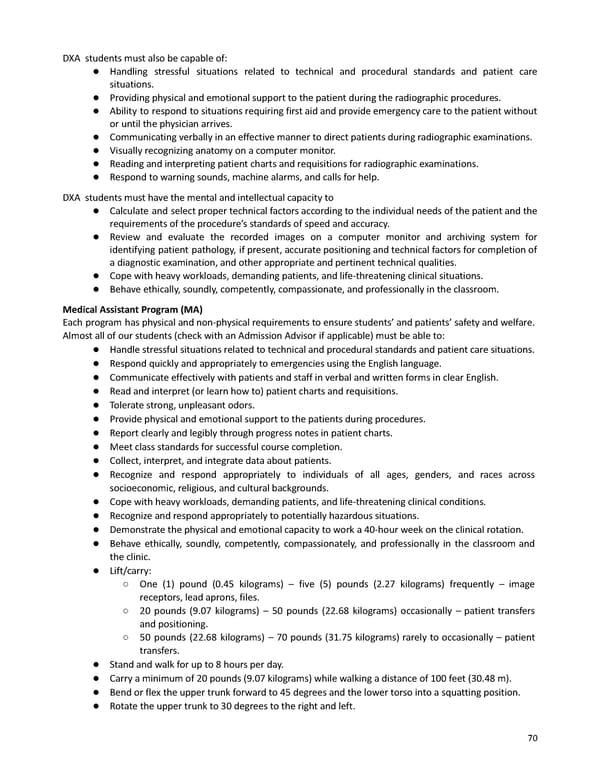DXA studentsmustalsobecapableof: ● Handling stressful situations related to technical and procedural standards and patient care situations. ● Providingphysicalandemotionalsupporttothepatientduringtheradiographicprocedures. ● Ability to respond to situations requiring first aid and provide emergency care to the patient without or until the physician arrives. ● Communicatingverballyinaneffectivemannertodirectpatientsduringradiographicexaminations. ● Visuallyrecognizinganatomyonacomputermonitor. ● Readingandinterpretingpatientchartsandrequisitionsforradiographicexaminations. ● Respondtowarningsounds,machinealarms,andcallsforhelp. DXA studentsmusthavethementalandintellectualcapacityto ● Calculate and select proper technical factors according to the individual needs of the patient and the requirementsoftheprocedure’sstandardsofspeedandaccuracy. ● Review and evaluate the recorded images on a computer monitor and archiving system for identifying patient pathology, if present, accurate positioning and technical factors for completion of adiagnostic examination, and other appropriate and pertinent technical qualities. ● Copewithheavyworkloads,demandingpatients,andlife-threateningclinicalsituations. ● Behaveethically,soundly,competently,compassionate,andprofessionallyintheclassroom. MedicalAssistantProgram(MA) Each program hasphysical and non-physical requirements to ensure students’ and patients’ safety and welfare. Almostall of our students (check with an Admission Advisor if applicable) must be able to: ● Handlestressfulsituationsrelatedtotechnicalandproceduralstandardsandpatientcaresituations. ● RespondquicklyandappropriatelytoemergenciesusingtheEnglishlanguage. ● CommunicateeffectivelywithpatientsandstaffinverbalandwrittenformsinclearEnglish. ● Readandinterpret(orlearnhowto)patientchartsandrequisitions. ● Toleratestrong,unpleasantodors. ● Providephysicalandemotionalsupporttothepatientsduringprocedures. ● Reportclearlyandlegiblythroughprogressnotesinpatientcharts. ● Meetclassstandardsforsuccessfulcoursecompletion. ● Collect,interpret, and integrate data about patients. ● Recognize and respond appropriately to individuals of all ages, genders, and races across socioeconomic, religious, and cultural backgrounds. ● Copewithheavyworkloads,demandingpatients,andlife-threateningclinicalconditions. ● Recognizeandrespondappropriatelytopotentiallyhazardoussituations. ● Demonstratethephysicalandemotionalcapacitytoworka40-hourweekontheclinicalrotation. ● Behave ethically, soundly, competently, compassionately, and professionally in the classroom and theclinic. ● Lift/carry: ○ One (1) pound (0.45 kilograms) – five (5) pounds (2.27 kilograms) frequently – image receptors, lead aprons, files. ○ 20 pounds (9.07 kilograms) – 50 pounds (22.68 kilograms) occasionally – patient transfers andpositioning. ○ 50 pounds (22.68 kilograms) – 70 pounds (31.75 kilograms) rarely to occasionally – patient transfers. ● Standandwalkforupto8hoursperday. ● Carryaminimumof20pounds(9.07kilograms)whilewalkingadistanceof100feet(30.48m). ● Bendorflextheuppertrunkforwardto45degreesandthelowertorsointoasquattingposition. ● Rotatetheuppertrunkto30degreestotherightandleft. 70
 2023-2024 | Catalog Page 69 Page 71
2023-2024 | Catalog Page 69 Page 71